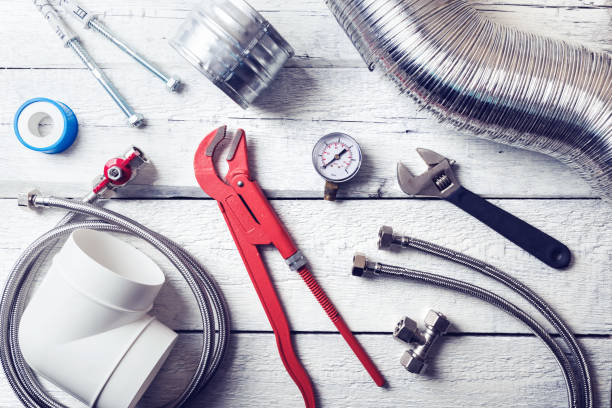Air Conditioning Tools

Essential HVAC Tools Australia: Equipping Your Kit for Success
Being an HVAC professional, whether experienced or inexperienced, necessitated using the appropriate instruments. When determining what goes in the toolbox, you'll need a mix of essentials and specialised products targeted for this application & air conditioning tools.
HVAC Shop has a collection of different HVAC tools from different brands that will help fill your tool kit!
IMPORTANT HVAC TOOLS EVERY HVAC PRO SHOULD HAVE
Reciprocating Saw Blades
The capacity of a reciprocating saw (also known as a Sawzall) to cut through almost anything makes it a useful and versatile instrument that no HVAC worker should be without. Though your technician will most likely purchase and maintain the saw, you should make sure they pick a new model with a high build quality that can last for years of everyday use. You'll also want to offer the blades they'll be using since the expense of maintaining them in stock pales in contrast to the time your firm could lose if techs attempt a complex cutting work with a dull blade.
Vacuum Pump
When you inject refrigerant in a leaky line, you're throwing good money after bad. It wastes time and supplies at best, and at worst, it could cause your client's air conditioning system to fail. The expensive repairs required to correct the problem (and the loss of that client's trust in you) will serve as a harsh reminder of the significance of performing the work correctly the first time.
The pump's capacity to suck moisture and air out of air conditioning pipes can aid in determining which lines have leaked before charging the system with refrigerant. As a result, you should give a reliable vacuum pump to each of your professionals. However, because of the broad range of models available, choosing which pump best meets your company's and technicians' demands might be challenging.
Refrigerant Scales
Those unfamiliar with the specifics of HVAC work may be startled to learn how precise many of the duties are. Consider the charging of a refrigerant-filled air conditioning system. The system will not be able to adequately maintain the temperature of its allotted space if there is insufficient power. Too much, on the other hand, generates a strong system within the cooling equipment, which can limit the compressor's lifespan and lead to costly maintenance concerns.
A refrigerant scale can assist solve these problems by weighing refrigerant as it is added to or removed from the compressor. It gives your specialist the information to put in just how much the system requires. That same capability aids your technician in detecting a leak in the design, allowing them to address a minor issue before it becomes a major one.
Pliers and Pipe Wrenches
While pipe wrenches are more often associated with plumbing, you can also use them on many HVAC systems with natural gas lines and plumbing connections. Keep a set of needle-nose, open-face, channel-lock, wire strippers, and linesman pliers available for smaller connections and easier wiring manipulation. You can avoid electrical shock by using pliers with insulated grips.
Multimeter
When your HVAC crew is working on the job, safety is paramount. Electrical mistakes jeopardise not only your technician's safety but can also cause significant damage to your client. Because HVAC systems are so closely linked to electrical systems, it's critical that your technicians have electrical testers on hand to check for live wires, measure voltage, evaluate resistance, and do other electrical tests rapidly in the field.
Tin Snips and Shears
Sheet metal manipulation tools are required in the HVAC industry. Make sure your HVAC technicians have all three types of tin snips: straight aviators, lefts (reds), and rights (blues) (greens). Every tin snip enables various positioning and cutting directions for more precision. A robust pair of steel shears with an insulated grip can assist your tech make longer, straight line cuts.
Portable Cordless Drill
A cordless drill is essential HVAC equipment because of its portability, efficiency, and versatility. Provide your technicians with an 18-volt drill and various bits, like Phillips, hex, hole saws, and arbours. To ensure that your technician's drill can last the whole day without recharging, maintain at least two batteries.
NEW HVAC TOOLS FOR ADVANCED TECHNICIANS
Nothing is more frustrating to an HVAC professional than having inadequate air conditioning tools for his job. Dealing with basic tools does not require much effort to improve one's skills. Advanced skills necessitate advanced gear. It's not only unpleasant but also restricting. Unfortunately, your dissatisfaction does not stop with you as a technician; it also affects your client. The tools that an advanced HVAC technician needs are discussed in this article.
These are the air conditioning tools used to service and configure HVAC systems in general, not just air conditioning systems. Most of the time, your employer will provide these tools, but it is good to double-check the tools you will be using regularly. It's far too late to study them once you have them. The following are the essential details.
Tubing Cutter
Copper lines are used in most air conditioning systems, and you will encounter them as an HVAC technician. Don't be concerned; the tubing cutter is here to assist you. The standard procedure begins with a deburring tool incorporated into the cutter's rear. It adjusts to various diameters of tubing or piping without issue.
Make final adjustments after adjusting the cutting wheel to suit the copper and spinning the tool a few times. It is not suggested to skip this step because it may damage the copper. The major purpose is to remove any burrs that may have been left behind, as these little bits can cause a system to fail if they get into the lines. Because cutting wheels become dull over time, they are usually replaceable.
Portable Digital Thermometer
One of the keys to optimal services and customer satisfaction is measuring the output temperature of the HVAC system.
Refrigeration Gauges
There are other refrigerants, but R-22 and R-410A are the most prevalent. However, having a tool that can handle more is essential. The manifold, gauges, and hose are the most important components. Hoses are occasionally available separately, and a lengthy hose is advised for jobs that require passing through tight locations. Finally, the brass fittings will be necessary to connect the hoses to the aircon system. As the law requires, these fittings must be rapid release and "de minimis," as the law requires. It's primarily to reduce the quantity of refrigerant that leaks into the environment while keeping you safe. Skin damage can result from coming into contact with a larger amount of refrigerant.
To ensure that refrigerants do not leak into the environment, they are recovered or removed from cooling equipment and air conditioning systems.
Carbon Monoxide Detector
The importance of safety in the HVAC sector cannot be overstated. This gadget is designed to be portable so that you may keep it with you at all times. It will assist you in detecting unsafe levels of carbon monoxide in your working environment.
Core Removal Tool
A core removal tool supports your technicians in removing and replacing broken cores.
Nitrogen Regulator
When purging and testing air conditioners and refrigeration systems, HVAC technicians need a professional tool to serve as a pressure control valve. That tool is called a nitrogen regulator.
Leak Detector
It can be hard to identify a leak if it is not obvious when it's too late. To swiftly locate the leaking source, HVAC experts use leak detectors to pinpoint locations with moisture.
HVAC Flaring Tool
Pipe fittings' adjustable mechanisms are known as flaring tools. They receive flexible metal piping and, if necessary, expand pipe sections' ends to enable the pipe to fit over to the next segment.

Psychrometer
Its primary duties are to measure and rate airflow, air mixes, and relative humidity as it exits a supply register. It tells an HVAC expert whether or not the heating and cooling system is working properly.
HVAC TOOLS FOR SAFETY
A top priority is ensuring the safety and protection of your HVAC technicians and clients on the job. A few of the particular safety items that your field employees will require as part of their HVAC tool kit are listed below.
Gloves
HVAC specialists must use gloves daily to be both comfortable and functional. Look for a pair of tough gloves with enough thickness to protect your hands while still allowing you to manoeuvre small instruments.
Masks
Another item of safety equipment that has become more crucial for technicians and customers is a face mask. Ensure your techs have several masks in their car and that they discard each one once they've worn it.
Goggles
You may kick up some small debris particles during some tasks performed by your HVAC personnel. Service technicians can see minor components more clearly with magnification goggles. It will lessen the likelihood of errors.
Earplugs
Some power tools are extremely loud, and prolonged usage can cause hearing loss and injury. Earplugs of the industrial grade will suffice to protect the ears of your technicians.
Shoes
Our final suggestion on this HVAC tools list is just as crucial as any others. HVAC professionals will be required to walk on diverse terrains while travelling between several job sites. It necessitates the use of appropriate footwear. Heavy steel-toed boots protect your field workers' feet from falling objects and prevent them from slipping.

GET ALL OF YOUR NEEDED HVAC TOOLS AUSTRALIA FROM THE HVAC SHOP
It's not always easy to service HVAC units for commercial or residential clients if you don't have your air conditioning tools. You'll need a knowledgeable team with access to the proper HVAC gear and equipment. Some technicians may be required to provide their basic tools for smaller assignments. On the other hand, larger-ticket items will necessitate significantly more sophisticated equipment.
Get everything you need for your HVAC business in Australia! We offer different HVAC tools and HVAC tool kits that will cater to your needs. You may also contact our customer service for more questions and concerns.









